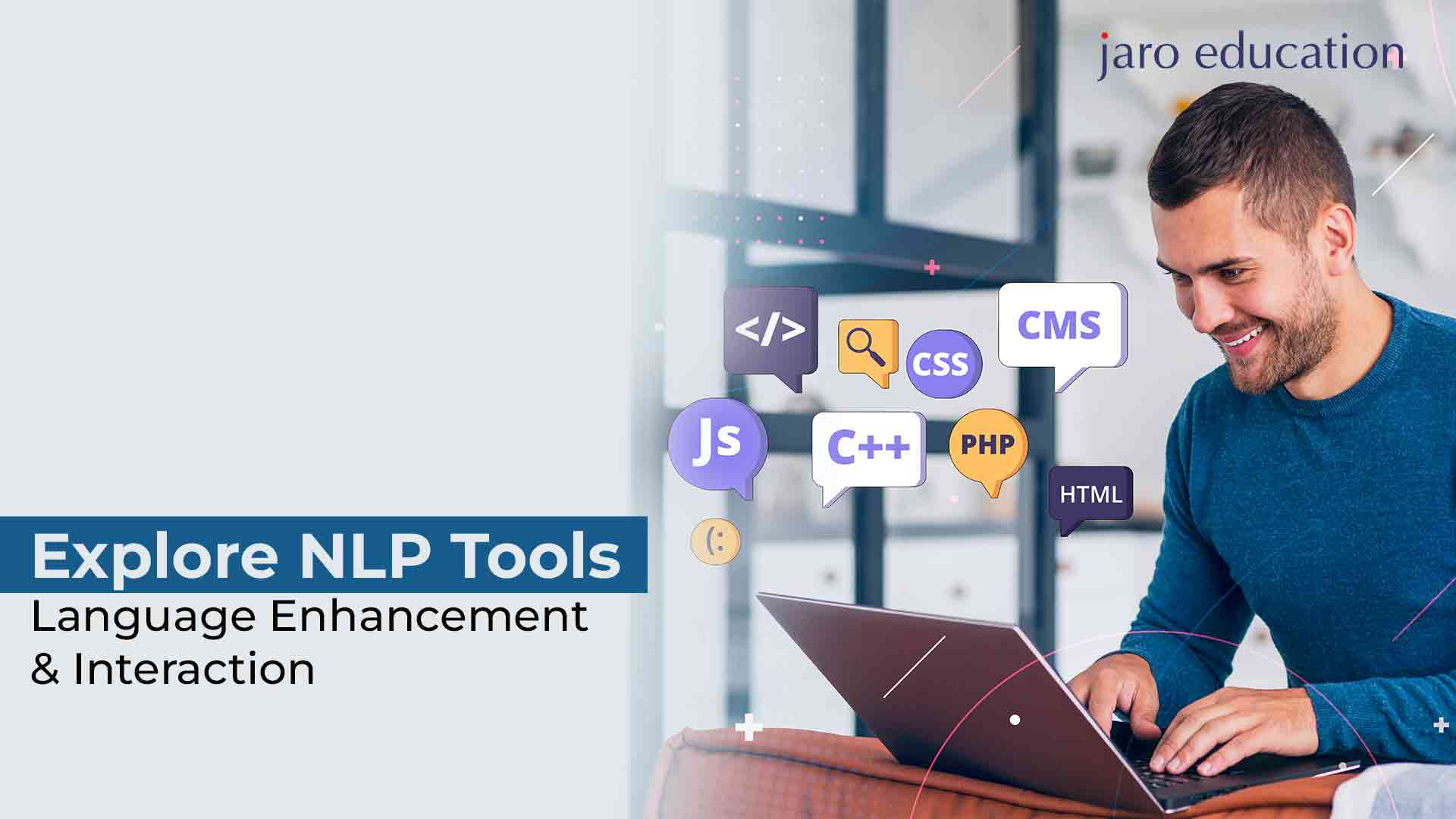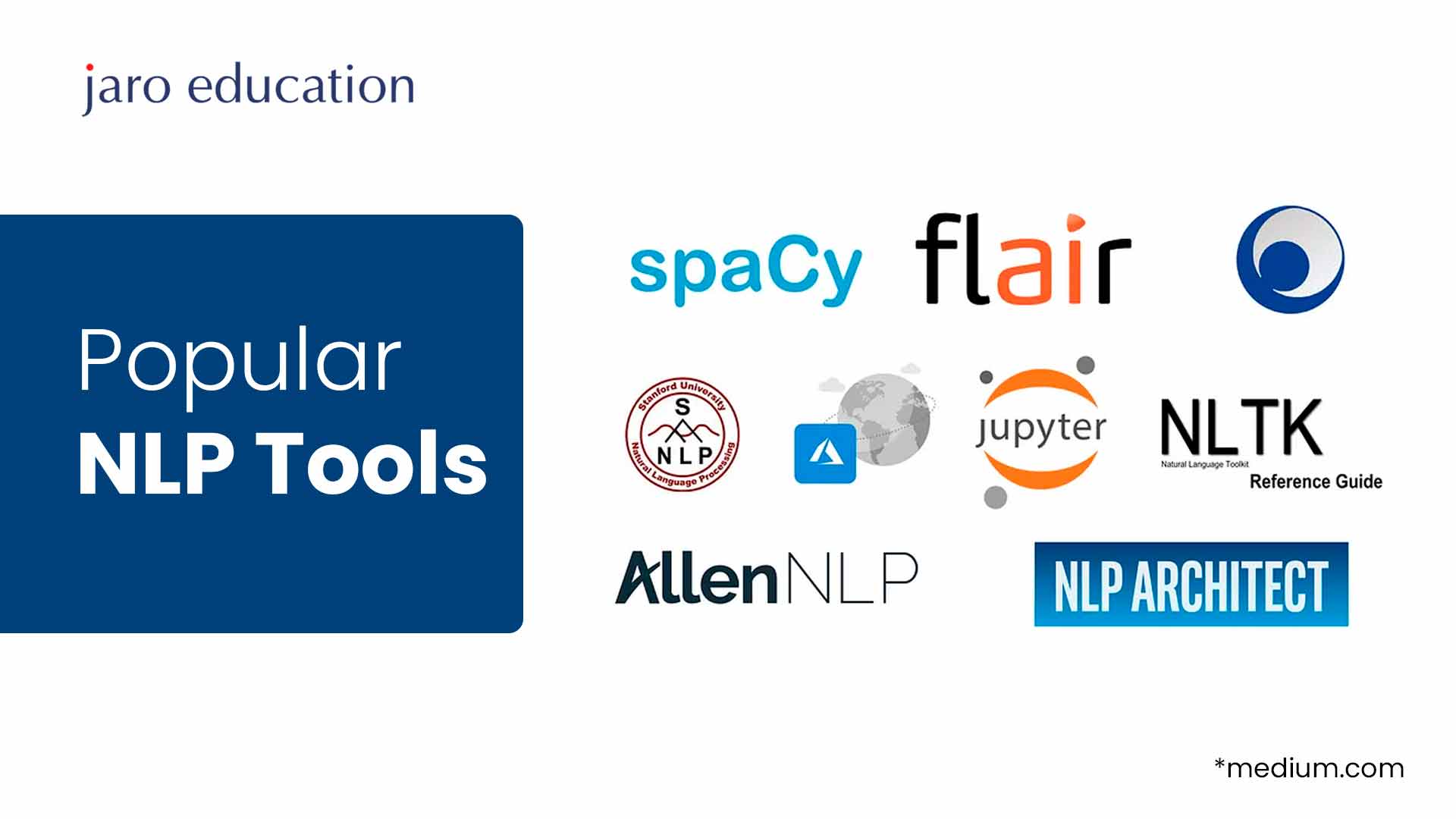Explore NLP Tools - Language Enhancement & Interaction
Table of Contents

- jaro education
- 31, October 2023
- 5:00 pm
Natural Language Processing, or NLP, is a part of Data Science (AI, to be precise) that allows computers to understand spoken words and text like humans. It combines machine learning, statistical learning, and deep learning models, enabling computers to process human language through voice or text. There are several NLP tools that understand human language to the fullest and translate it into text or voice output. NLP tools further provide business solutions to various companies and streamline their operations. To understand how, let’s delve into NLP and its core aspects.
What is the Work of NLP?
NLP (Natural Language Processing) uses various algorithms and breaks down human voice data and text to help computers understand their expression. There are several tasks of NLP, which include:
Sentiment Analysis
NLP tools aim to gather subjective aspects from text, like confusion, emotion, sarcasm, suspicion and attitude from a text.
NEM
Also known as Named Entity Recognition, it identifies phrases or words as important entities. NEM is a part of NLP that may recognize ‘Riya’ as a woman’s name and ‘Starbucks’ as an eatery.
Speech Recognition
Turning voice input into text data is called speech-to-text. Speech recognition is an important work of NLP for applications that respond to voice commands or enquiries. The way people talk makes speech recognition quite challenging. Using different accents, slurring words together, using diverse annotations and using incorrect grammar can make speech recognition difficult.
Language Disambiguation
NLP determines the meaning of a word with several meanings using semantic analysis to discover which word makes the most sense in the current context. Language disambiguation, for example, aids in distinguishing the meaning of the verb ‘make’ in ‘make the grade’ (achieve) vs. ‘make a bet’ (place).
Co-reference Resolution
Determining whether two words refer to the same item is known as co-reference resolution. The most typical example is recognizing the person or thing to whom a given pronoun refers (e.g. ‘she’ = ‘Mary’), but it may also include identifying a metaphor or an idiom in the text (e.g., an instance in which ‘bear’ refers to a giant hairy person rather than an animal).
Grammatical Tagging
Grammatical tagging is also called a part of speech tagging. It is a task of NLP to identify the part of speech of a given word or piece of text according to its context and use. Part of speech determines ‘make’ as a noun in ‘What make of car do you own?’ and as a verb in ‘I can make a paper plane’.
Natural Language Generation
It is the opposite of speech recognition. Here, NLP structures information into human language.
What are the NLP Tools Available in the Market?
Natural Language Processing assists businesses in making and discovering useful insights from unstructured text as well as solving a number of text analysis challenges, such as subject categorisation, sentiment analysis and more. Various ready-to-use NLP tools can be run through open-source libraries or SaaS (software as a service). The top NLP tools are:
Google Cloud
The Google Cloud Natural Language API includes different pre-trained models for entity extraction, sentiment analysis and content categorization. Google Cloud as AutoML Natural Language, which allows businesses to create personalized machine learning models. It makes use of Google question-answering and language comprehension technologies as part of the Google Cloud architecture.
NLTK
The Natural Language Toolkit (NLTK) in Python is a significant tool for developing Natural Language Processing (NLP) models. NLTK is dedicated to NLP research and education and is equipped with datasets, resources, and language processing tools, including an extensive Python handbook and Language Processing. Although becoming proficient in this library requires time and effort, it offers an excellent environment for acquiring practical NLP skills. NLTK’s modular design enables it to offer a range of components for various NLP tasks, including stemming, tokenizing, tagging, classification, and parsing.
TextBlob
A Python module, TextBlob extends NLTK and enables businesses and individuals to execute the same. NLP operations in a more intuitive and user-friendly interface. It has a simpler learning curve than other open-source libraries, making it a good alternative for novices who wish to tackle NLP tasks such as text categorisation, sentiment analysis, part-of-speech tagging, and more.

Stanford Core NLP
Stanford University’s NLP community maintains the well-known library Stanford Core NLP. It’s developed in Java, so there is no need to install JDK on a computer, although it supports most programming languages through APIs. The Core NLP toolbox enables users to do NLP tasks like tokenization, part-of-speech tagging and named entity identification. Performance optimization and scalability are its key features, making it an excellent solution for difficult jobs.
SpaCy
SpaCy is a modern open-source Python module for Natural Language Processing, known for its remarkable speed, user-friendliness, extensive documentation, and robust data handling capabilities. Unlike NLTK or CoreNLP, which show a variety of algorithms for each job, SpaCy keeps its menu brief and puts up the best available choice for each task. This library is an excellent choice for preparing text for deep learning and excels at extraction tasks and is only available in English.
Flair
Flair is a simple Natural Language Processing tool that was developed by Zalando Research. The framework of Flair is created directly on PyTorch and is one of the best learning frameworks there. The tool comprises various pre-trained models to perform tasks including text classification, name-entity recognition, parts-of-speech tagging and training custom models. The user interface of Flair allows coders and developers to combine different word embeddings like BERT, GloVe and more.
NLP Architect
NLP Architect is an open-source Python library for NLP, developed by Intel. This library enables developers, data scientists and researchers to investigate sophisticated deep-learning approaches in natural language processing and interpretation. Its core models allow heavy extraction of linguistics for NLP workflows. With chatbot integrations, users can practise smart capabilities like semantic parsing, name-entity recognition and intent extraction.
Amazon Comprehend
It is a natural language processing (NLP) service embedded in the Amazon Web Services architecture. This API may be used for NLP activities, including sentiment analysis, topic modeling, entity identification, and more.
IBM Watson
Present in the IBM Cloud, IBM Watson is a suite of AI services that provides Natural Language Understanding as the key feature. With this mechanism, users can discover and extract entities, categories, emotions and more.
What are the Techniques of NLP?
The techniques of Natural Language Processing (NLP) are classified into two broad categories: syntax and semantics.
The arranging of words in a phrase to produce grammatical meaning is known as syntax. NLP uses syntax to evaluate the meaning of a language based on grammatical rules. Syntax techniques are of four types:
Stemming
This separates words with inflexion into root forms. For instance, in the line “The dog barked,” the algorithm would recognize that the root of the word “barked” is “bark.” This would be handy if a user was looking for all instances of the word bark, as well as all of its conjugations, in a document. Even if the characters are different, the algorithm recognizes them as the same term.
Sentence breaking
This method creates sentence boundaries in large texts, which simplifies the task of splitting textual data into sentences and as a result, increases the length of the output.
Morphological segmentation
This is the technique of creating word forms from a text string. For example, a person scans handwritten paper into a computer. With the help of this tool, the page will be evaluated and might conclude that white spaces divide the text.
Word segmentation
This is the process of generating word formations from a string of text.
Semantics is concerned with the usage and meaning of words. Algorithms are used in natural language processing to comprehend the meaning and structure of phrases. Semantic methods include natural language generation, language disambiguation and named entity recognition.
Advantages of Natural Language Processing
The primary advantage of NLP is that it enhances how people and computers interact with one another. The computer’s language – Code, is the most direct approach to influencing a computer. Interacting with computers becomes much more intuitive for people as computers learn to grasp human language.
NLP’s other advantages are as follows:
- Helps to perform sentiment analysis
- Improves the efficiency and accuracy of documentation
- Utilising NLP, personal assistants such as Alexa comprehend spoken words.
- Provides the ability to automatically make a readable summary of complex and larger unique texts.
- Allows organisations to use chatbots for customer support
- Offers useful insights into analytics that were once difficult to reach due to the volume of data.
Explore Popular Blogs on Data Science
Thus, Natural language processing is critical to technology and how humans interact with it. It is utilized in a wide range of real-world applications, including chatbots, cybersecurity, search engines, and big data analytics. In the coming years, NLP is projected to remain a significant aspect of both industry and daily life.
As an important aspect of Data Science, mastering Natural Language Processing offers great career opportunities to professionals. And if you pursue a specific course, it can advance various job roles in reputed companies. IIM Kozhikode is offering a Professional Certificate Programme in Data Science for Business Decisions, which is one such course that provides students with critical and analytical thinking abilities in programming and data science. With this 1-year certification course, you can acquire knowledge and skills from industry experts, work on capstone projects, and much more.











